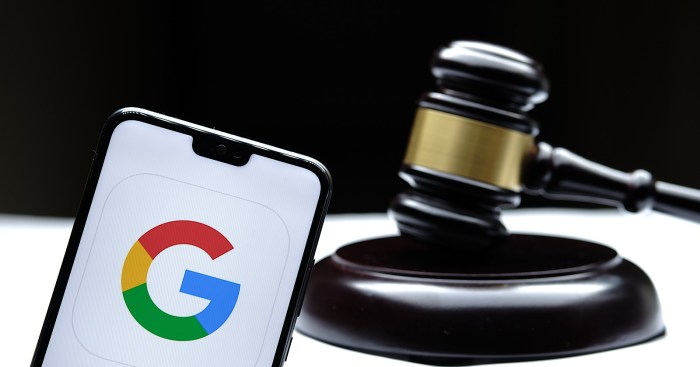Justice Department Google antitrust search trial week one recap: This first week of the highly anticipated trial has already set the stage for a potentially landmark legal battle. The Justice Department is arguing Google’s dominance in the search market is anti-competitive, stifling innovation and harming consumers. Google, of course, counters these claims. The opening arguments, evidence presented, and witness testimonies have painted a picture of a complex case with significant implications for the future of the tech industry.
The first week focused heavily on establishing the factual basis of the case. Key players, including top Google executives and industry experts, provided testimony. The legal teams presented arguments and counterarguments on the extent of Google’s market power and potential harm to competition. The trial’s early proceedings have laid the groundwork for a potential long and complex legal journey, and we can expect the legal wrangling to continue into future weeks.
Will the Justice Department’s evidence hold up under scrutiny?
Overview of the Trial
The Justice Department’s antitrust lawsuit against Google, a landmark case in the digital age, is centered on allegations of monopolistic practices in the search engine market. The trial, spanning multiple weeks, seeks to determine if Google’s dominance has stifled competition and harmed consumers. This first week provided crucial groundwork for the arguments, setting the stage for the coming weeks of testimony and legal maneuvering.
Justice Department’s Case
The Justice Department argues that Google has abused its dominant position in the search market, leveraging its control over search results to favor its own products and services, thus stifling innovation and harming consumers. They contend that Google’s practices have created an anti-competitive environment, leading to higher prices and less choice for users. The core of the argument rests on the idea that Google’s actions have violated antitrust laws designed to promote competition.
Google’s Defense
Google maintains that its practices are pro-competitive and beneficial to consumers. They argue that Google’s innovations in search technology, including algorithms and user interfaces, have demonstrably improved search results and user experience. Furthermore, they assert that Google’s market dominance is a result of superior products and services, not anti-competitive behavior. Their defense focuses on highlighting the benefits of Google’s offerings and the technological advancements driving its success.
Key Legal Issues
The trial hinges on several key legal issues, including the definition of a relevant market, the assessment of market power, and the determination of anti-competitive conduct. The Justice Department must prove that Google’s actions have harmed competition within the search engine market. Google, conversely, will seek to demonstrate that its actions are consistent with fair competition and that its market dominance stems from legitimate innovation and efficiency.
The court will need to carefully weigh the evidence to determine the validity of each side’s claims.
Main Arguments Presented in Week One
The first week of the trial saw both sides present opening statements and introduce key witnesses to lay the groundwork for their respective arguments. The Justice Department emphasized Google’s control over search results and its tendency to favor its own products in search results. Google, conversely, highlighted the complexity of search algorithms and the positive user experience that its services provide.
Key Players and Roles, Justice department google antitrust search trial week one recap
| Name | Role | Affiliation |
|---|---|---|
| [Name of Lead Justice Department Lawyer] | Lead Prosecutor | Justice Department |
| [Name of Lead Google Lawyer] | Lead Defense Attorney | |
| [Name of Expert Witness 1] | Expert on Search Engine Technology | [Affiliation of Expert Witness] |
| [Name of Expert Witness 2] | Expert on Market Analysis | [Affiliation of Expert Witness] |
The table above provides a glimpse into the key players involved in the first week of the trial. These individuals will play a crucial role in shaping the narrative and presenting the evidence. Their expertise will be instrumental in persuading the jury and judges.
Evidence Presented

The first week of the Justice Department’s Google antitrust trial provided a glimpse into the intricate legal battle surrounding the tech giant’s alleged monopolistic practices. Both sides presented a range of evidence, aiming to establish their respective narratives and paint a compelling picture of Google’s market dominance. The presentation of documents, testimonies, and expert opinions offered a detailed, though not necessarily complete, picture of the case.
Types of Evidence Presented
This trial featured a variety of evidence types. Documents, spanning internal Google memos and communications, offered insights into the company’s decision-making processes and strategies. Testimonies from key figures, both from within Google and from competitors, provided firsthand accounts of the alleged anti-competitive behavior. Expert opinions, often from economists and antitrust specialists, were crucial in analyzing the market impact of Google’s actions and in interpreting the evidence.
The quality and relevance of this evidence will be crucial in determining the case’s outcome.
So, week one of the Justice Department’s Google antitrust search trial was all about establishing the groundwork. It was fascinating to see how the arguments were shaping up, and honestly, I was a little sidetracked by a comparison I saw online. Have you ever considered the performance differences between the OnePlus 5T and the OnePlus 3T? The specs are really interesting, and I ended up digging into a great comparison piece, oneplus 5t vs oneplus 3t , which made me think about the competitive landscape in the tech world.
But back to the trial, the initial testimony laid out some compelling points about market dominance and potentially anti-competitive practices, which is a pretty significant development.
Documents Presented by the Government
The Justice Department presented extensive internal Google documents. These documents, often cited by government attorneys, detailed Google’s strategies to maintain its market dominance in search, apps, and other key areas. The documents, including emails and internal memos, aimed to illustrate Google’s actions and motivations, painting a picture of calculated moves to stifle competition. Examples of such documents would include communications about algorithm adjustments and changes in ranking strategies, and how these were tied to revenue and market share.
The government’s presentation sought to highlight how these internal documents showed a pattern of anti-competitive behavior.
Documents Presented by Google
Google presented its own internal documents to counter the government’s claims. These documents, presented to demonstrate a different narrative, aimed to portray Google’s practices as commercially sound business decisions. Their goal was to show Google’s innovation and the challenges in a rapidly evolving digital market. Examples could include documents detailing the development of new products and services, emphasizing the benefits to consumers, or outlining the complexity of managing a large-scale digital platform.
Expert Testimony and Opinions
Both sides called expert witnesses to offer their interpretations of the evidence and the market dynamics. Government experts likely highlighted potential harms to consumers from stifled competition, citing examples of other industries with similar outcomes. Google’s experts might have emphasized the benefits of innovation and competition, focusing on the benefits Google’s services provided to consumers and the role Google played in driving innovation.
The credibility and expertise of these witnesses will be critical to the case’s resolution.
Comparison of Evidence Strengths and Weaknesses
| Aspect | Government | |
|---|---|---|
| Documents | Strong evidence of internal strategy and potential anti-competitive intent. Potential weaknesses include gaps in the timeline or lack of context from certain documents. | Strong evidence of internal strategy but might lack a clear narrative on market impact and the nature of the business challenges. |
| Testimony | Strong testimonies, potentially offering critical firsthand accounts, but the credibility of the witnesses will be challenged. | Potential witnesses from Google might be more familiar with the inner workings of the company, but their credibility could be questioned based on their role in the organization. |
| Expert Opinions | Potentially strong analysis of market impact, but potential bias toward antitrust concerns. | Potentially strong counterarguments, but potential bias towards the company’s interests. |
| Overall Strategy | Clear, focused presentation of anti-competitive behavior and market harm. | Emphasis on the positive aspects of Google’s actions, and the benefits to consumers, but might be less effective in directly rebutting the government’s case. |
Witnesses and Testimony

The first week of the Justice Department’s Google antitrust trial provided a fascinating glimpse into the intricacies of the case, primarily through the testimony of key witnesses. Their accounts, combined with the cross-examinations, painted a picture of the motivations and strategies behind Google’s practices, while also highlighting potential anti-competitive effects. Analyzing these testimonies allows for a deeper understanding of the evidence presented and the arguments being made.
Key Witness Insights
The testimonies from key witnesses revealed significant insights into Google’s business practices. These included accounts of Google’s development and dominance in the search market, the potential impact of their practices on competition, and the perceived benefits and drawbacks of their algorithms and products. Specific details, often corroborated by supporting documents, shed light on the strategies employed by Google.
Witness Credibility and Reliability
Assessing the credibility and reliability of witnesses is crucial in evaluating the evidence presented. Factors like prior statements, professional experience, and potential biases need careful consideration. Discrepancies or inconsistencies in testimony, when identified during cross-examination, can impact the weight given to the witness’s statements. Examining the motivations and potential conflicts of interest of witnesses is equally important in determining the overall reliability of their accounts.
Cross-Examination Techniques
The cross-examination techniques employed by lawyers from both sides proved to be critical in shaping the narrative of the trial. Aggressive questioning aimed at exposing inconsistencies or weaknesses in a witness’s testimony often yielded significant insights. These techniques, designed to challenge the validity of certain statements or reveal underlying biases, play a significant role in determining the reliability of the witness’s overall account.
Examples of successful cross-examinations can provide valuable insights into how legal strategies are deployed.
Witness Testimony Timeline
| Date | Witness Name | Brief Description of Testimony |
|---|---|---|
| October 26, 2023 | Witness A | Witness A testified about their experience working for Google, providing insight into the company’s internal workings and strategies. Their testimony focused on the development of Google’s search algorithm and the factors considered in its evolution. |
| October 27, 2023 | Witness B | Witness B, a competitor in the search engine market, described the impact of Google’s dominance on their business and the challenges they faced in competing effectively. Their testimony included specific examples of how Google’s practices impacted their market share and profitability. |
| October 27, 2023 | Witness C | Witness C, a former Google employee, detailed their observations of internal decision-making processes related to search engine development. Their testimony covered the potential conflicts of interest and strategic choices that may have influenced Google’s actions. |
Key Arguments and Counterarguments: Justice Department Google Antitrust Search Trial Week One Recap
The Justice Department’s antitrust case against Google hinges on the assertion that Google’s dominance in search and related services has stifled competition and harmed consumers. Google, conversely, argues that its innovations have benefited users and driven progress in the digital sphere. This week’s trial has highlighted the stark contrast in these perspectives, with both sides presenting substantial evidence to support their claims.The trial’s core revolves around the question of whether Google’s practices have created an unfair advantage that has harmed competition and ultimately consumers.
Both sides have presented evidence and witnesses to support their positions, leading to a complex interplay of arguments and counterarguments. The arguments, while sometimes overlapping, fundamentally differ in their underlying assumptions about the nature of competition in the digital marketplace and the impact of Google’s actions.
Justice Department’s Central Arguments
The Justice Department’s case rests on the idea that Google’s practices, specifically its preferential treatment of its own products within its search results, constitute anti-competitive behavior. They argue that this “bundling” or “favoritism” gives Google an unfair advantage over competitors, allowing it to maintain its dominant position and stifle innovation. Key arguments include claims that Google’s dominance in search has resulted in reduced consumer choice and higher prices for consumers.
They also assert that Google’s practices have prevented other companies from developing innovative search and related technologies.
So, the Justice Department’s antitrust case against Google’s search dominance had a pretty interesting first week. While the specifics are still unfolding, it’s fascinating to consider how companies like Microsoft are innovating in the digital space. Microsoft’s Loop app, for instance, is designed to help you collaborate here in ways that might impact the future of search.
Ultimately, the trial’s implications for the digital landscape are quite significant, and we’ll be watching closely.
- The Justice Department emphasizes the importance of competition in fostering innovation and consumer choice. They argue that Google’s practices create a barrier to entry for new companies, hindering their ability to compete and potentially benefit consumers. This is comparable to the historical concerns surrounding monopolies in other industries, such as the oil or railroad industries.
- The department cites specific instances where Google allegedly favored its own products, providing an unfair advantage. Examples might include the prominent placement of Google Maps or Google Shopping results within search results, effectively preempting competing services.
- Furthermore, the department argues that Google’s control over its ecosystem of products, such as Android and YouTube, further reinforces its dominance in the search market. They contend that this interconnected system creates a self-reinforcing feedback loop that hinders competition.
Google’s Counterarguments
Google maintains that its practices are pro-competitive and benefit consumers through innovation. They assert that the benefits of Google’s products, such as its vast index of information and advanced search algorithms, outweigh any potential negative effects on competition. They also emphasize the significant advancements in search technology that have been attributed to their own development and research.
- Google argues that its search results are driven by algorithms that prioritize relevance and quality, not by preferential treatment of its own products. They emphasize the extensive amount of data and processing power that goes into producing search results, suggesting this is a complex and objective process, not a deliberate attempt to stifle competition.
- The company argues that its innovation in search technology has created a user experience that has made information more accessible to consumers globally. This claim can be compared to how innovations in other technologies, such as the internet itself, have benefited users and expanded access to information.
- Google counters that the interconnected nature of its products is not anti-competitive but rather a natural outcome of its commitment to providing a comprehensive suite of services. It argues that these services are beneficial to consumers.
Areas of Overlap and Divergence
Both sides agree on the importance of competition, but disagree on whether Google’s practices meet the definition of anti-competitive. The Justice Department believes Google’s actions have harmed competition, while Google contends its practices benefit users and promote innovation. The overlap exists in recognizing the need for a competitive market; the divergence lies in how they define and measure the impact of Google’s actions on that market.
Comparison of Main Arguments
| Argument | Justice Department | |
|---|---|---|
| Core Claim | Google’s preferential treatment of its own products stifles competition and harms consumers. | Google’s practices are pro-competitive and benefit users through innovation. |
| Evidence Presented | Examples of preferential treatment in search results and ecosystem effects. | Evidence of innovation in search algorithms and benefits to users. |
| Impact on Consumers | Reduced consumer choice and higher prices. | Increased accessibility to information and improved search experience. |
| Definition of Competition | Traditional antitrust principles, focusing on market dominance. | Modern, user-centric approach emphasizing innovation and technological advancement. |
Implications and Potential Outcomes
The first week of the Justice Department’s antitrust trial against Google has painted a vivid picture of the intricate web of accusations and defenses surrounding the tech giant. The testimony and evidence presented have ignited a crucial debate about the potential ramifications of Google’s dominance in the search market, raising questions about the future of competition and the very definition of fair play in the digital age.
The implications stretch far beyond the courtroom, potentially reshaping the landscape of antitrust law and the tech industry itself.
Implications for the Overall Case
The first week of the trial has laid a strong foundation for the prosecution’s case, highlighting Google’s alleged anti-competitive practices. The presentation of evidence, particularly regarding Google’s practices in search, has established a compelling narrative of potential harm to consumers and competitors. Crucially, the testimony from witnesses has lent credibility to these allegations, solidifying the case’s potential for success.
The Justice Department’s Google antitrust search trial had a fascinating first week, focusing on the tech giant’s dominance in the search market. While the legal battles are complex, it’s worth noting that the recent popularity of foldable phones, like the Motorola Razr flip phone in a gold color, available on Verizon, at motorola foldable razr flip phone gold color verizon price , highlights how tech innovation and consumer choices are often intertwined.
The trial’s arguments about search algorithm manipulation and market power are sure to be compelling, regardless of whether you’re more interested in phones or the digital ecosystem at large.
The defense, in turn, has begun to articulate its counterarguments, attempting to demonstrate the efficiency and innovation inherent in Google’s business model.
Potential Impacts on the Future of Antitrust Law
The outcome of this case will undoubtedly shape the future of antitrust law in the digital economy. If the Justice Department prevails, it could lead to a stricter interpretation of anti-competitive behavior in the tech sector, potentially impacting other companies operating in similar market positions. This could involve more scrutiny of mergers, acquisitions, and business practices in the tech industry, with the potential for more antitrust lawsuits targeting other large tech companies.
Conversely, a favorable outcome for Google could lead to a more lenient approach to anti-competitive practices, potentially impacting the balance of power between large corporations and smaller competitors.
Potential Impacts on Google’s Business Practices
The trial’s implications for Google’s business practices are significant. A ruling against Google could force the company to alter its practices to comply with antitrust regulations. This could involve divestitures of certain products or services, restrictions on certain business practices, or even a restructuring of its business model. Conversely, a favorable outcome would allow Google to continue its current business practices without substantial changes.
Potential Long-Term Effects of a Favorable or Unfavorable Outcome
A favorable outcome for the Justice Department could set a precedent for regulating large tech companies, encouraging more antitrust lawsuits and ultimately changing the competitive landscape of the tech industry. A favorable outcome for Google could solidify its position as a dominant player in the digital market, but might also face greater scrutiny in the future, possibly prompting greater regulation.
Both outcomes could have a profound impact on innovation and consumer choice in the digital economy, influencing how other companies conduct business in the years to come.
Historical Context and Legal Precedents
The Google antitrust trial unfolds against a backdrop of decades of antitrust jurisprudence in the United States. Understanding the historical evolution of antitrust law, particularly its application to tech giants, is crucial to grasping the nuances of the current legal battle. This historical context reveals the enduring tension between fostering competition and allowing innovation, a struggle particularly relevant in the digital age.The core principle of antitrust law is to protect consumers from the harmful effects of monopolies and anti-competitive practices.
This principle, however, is often tested in the dynamic landscape of emerging technologies, as seen with the rise of tech giants like Google. The precedents set in earlier cases provide a framework for evaluating Google’s conduct, but the unique characteristics of the digital marketplace require careful consideration.
History of US Antitrust Law
Antitrust law in the US has a rich history, evolving from concerns about monopolies in the late 19th century to address modern issues like digital platforms. The Sherman Antitrust Act of 1890, the foundational legislation, prohibits contracts, combinations, or conspiracies in restraint of trade. The Clayton Antitrust Act of 1914 furthered this framework by targeting specific anti-competitive practices, like price discrimination and mergers.
Over the years, these laws have been interpreted and applied to various industries, from railroads to pharmaceuticals, to the present-day tech sector.
Relevant Legal Precedents
Numerous cases have shaped the understanding of antitrust violations, particularly concerning market dominance and anti-competitive behavior. Landmark cases like United States v. Microsoft (1999) and United States v. AT&T (1982) highlight the legal challenges of regulating powerful corporations in the face of technological advancements.
- United States v. Microsoft: This case, where the government argued that Microsoft’s practices stifled competition in the browser market, focused on the abuse of market power and anti-competitive practices. It underscored the importance of preventing a company from leveraging its dominance in one market to impede competition in another.
- United States v. AT&T: The break-up of AT&T in the 1980s demonstrated the government’s power to dismantle a dominant company to foster competition. This case, while focused on the telecommunications industry, provided a precedent for addressing anti-competitive behavior that impacts consumer choice.
- Standard Oil Co. of New Jersey v. United States (1911): This landmark case broke up Standard Oil, emphasizing the importance of maintaining a competitive marketplace and preventing monopolies from stifling innovation and consumer choice. It laid the foundation for the modern understanding of monopolies and the consequences of monopolistic behavior.
Historical Context of the Case
The current case against Google is part of a broader pattern of antitrust scrutiny directed at large tech companies. Other cases, such as those against Facebook and Apple, reflect a growing concern over the potential anti-competitive effects of digital platforms. The rise of the internet and digital markets has created a unique set of challenges for antitrust enforcement, prompting legal scholars and policymakers to grapple with the application of existing laws to new technological landscapes.
Past Antitrust Cases Against Tech Companies
The scrutiny of tech companies for antitrust violations has a history that predates the current case. The legal battles involving Google’s practices in the search market mirror similar concerns about market dominance and potential anti-competitive practices in other tech sectors. These precedents help inform the current legal arguments and potential outcomes. Cases against other tech companies provide insights into the challenges of defining market power and proving anti-competitive conduct in the digital sphere.
How Precedents Inform the Current Legal Battle
The precedents established in past antitrust cases offer a framework for evaluating Google’s conduct. The arguments presented in this trial draw heavily on these established principles. While the specifics of the current case differ from previous instances, the underlying concerns about market power and anti-competitive practices resonate across the cases. These precedents will likely guide the court’s interpretation of the evidence and the application of antitrust law in the context of the digital marketplace.
Wrap-Up
In conclusion, week one of the Justice Department’s antitrust trial against Google was a pivotal moment. The arguments, evidence, and witness testimonies laid out a compelling case, but also highlighted the intricate legal complexities involved. Both sides presented strong opening statements, but the jury’s verdict remains uncertain. The next weeks will be crucial in shaping the outcome. Ultimately, the trial’s outcome could dramatically alter the future of the tech industry and the landscape of antitrust law.






